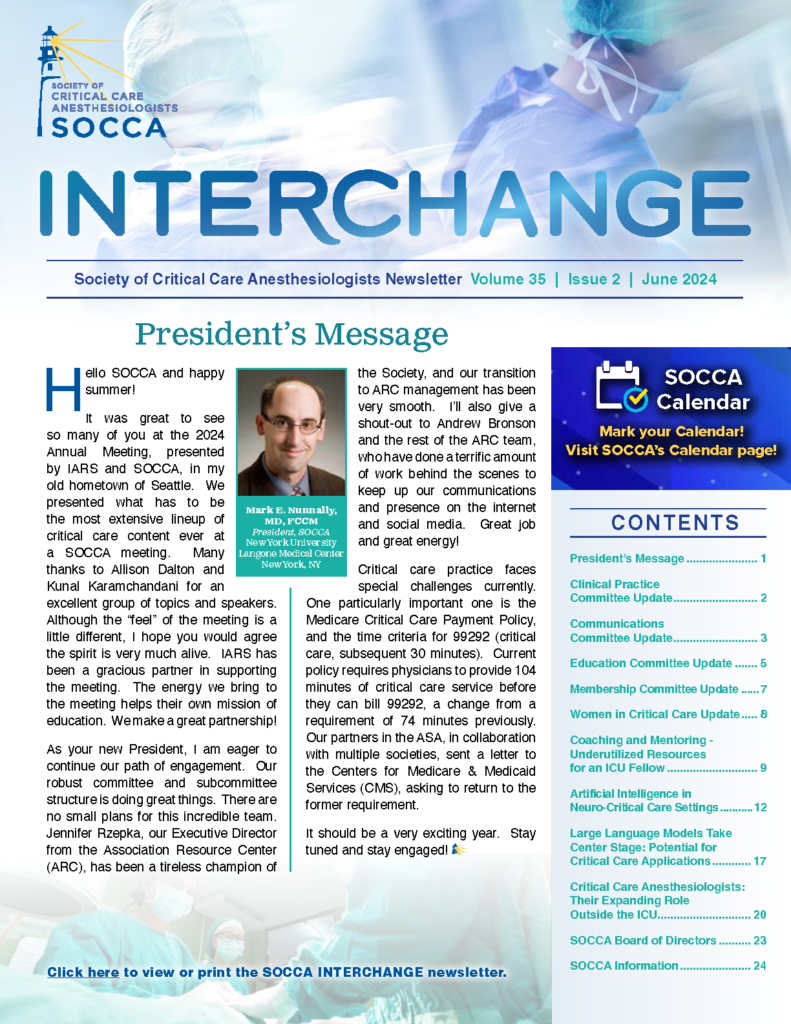Ultrasound for Airway Management: Is it all Hocus POCUS?
Bedside point-of-care ultrasound (POCUS) has become ubiquitous in the critical care arena and is an essential tool for intensivists. POCUS has been used extensively to diagnose various cardiovascular and respiratory pathologies in critically ill patients and is now an integral part of various diagnostic algorithms in the intensive care unit (ICU). Yet, despite the proliferation of various portable and handheld devices, POCUS during emergency airway management in critically ill patients has never taken off.
The so-called “difficult airway” has traditionally described the anatomic difficulties associated with challenging visualization of the vocal cords and/or difficulty with placement of the endotracheal tube. With the almost universal adoption of video-laryngoscopy, however, such scenarios have become less commonplace. Nonetheless, complications associated with tracheal intubation in critically ill patients remain high. A recent international study found that 40.7% of critically ill patients undergoing tracheal intubation had a major adverse peri-intubation event, of which, cardiovascular instability was the predominant event1. Patients who experienced a major event also had a higher 28-day mortality. This highlights the significant risks associated with this commonly performed procedure, aligning with the concept of “physiologically difficult airway,” wherein the patients’ physiological state predisposes them to cardiorespiratory complications during tracheal intubation and/or initiation of positive pressure ventilation2.
Logically, hemodynamic optimization prior to and/or during tracheal intubation is essential but is often not considered or is inappropriate. Pre-emptive fluid administration is common prior to tracheal intubation, however, its role in improving outcomes is unclear. In a recent randomized controlled trial evaluating the impact of fluid bolus administration on peri-intubation hemodynamics, cardiovascular collapse was observed in about 20% of patients 3. Similarly, the impact of pre-emptive administration of vasopressors is unclear. While there is no clear evidence that this strategy works, the Effect of a Fluid Bolus or a Low Dose Vasopressor Infusion on Cardiovascular Collapse Among Critically Ill Adults Undergoing Tracheal Intubation (FLUVA Trial) NCT05318066, is currently underway to better delineate the role of fluid loading versus early use of low dose vasopressors in decreasing the incidence of cardiovascular collapse during tracheal intubation. An individualized approach to using fluids, vasopressors, and/or ionotropic administration to optimize peri-intubation hemodynamics is probably most appropriate, and we believe that POCUS is an important tool in our armament for this endeavor 4.
A detailed description of the focused transthoracic exam is beyond the scope of this article. We prefer utilizing the rapid ultrasound in shock (RUSH) protocol to evaluate patients with peri-intubation hypotension rapidly and reliably 5. Separating the evaluation into 3 components (the pump, the tank, and the pipes) allows for the assessment of multiple organ systems simultaneously to identify and differentiate the various shock states and to guide the next steps regarding optimization and management. Other resuscitative protocols are described in the literature as well, but one of the barriers to adoption is the perceived additional workload associated with the performance of POCUS in such time-limited circumstances.
Similarly, the logistics regarding the availability of the equipment and trained personnel is another deterrent. In addition, depending on the presence, type, and degree of pulmonary disease, parasternal and apical views may be difficult to obtain. In more pressing situations, and in situations when the subxiphoid window might be the only window readily available, a subxiphoid-only view assessment (EASy) provides sufficient information in most patients to narrow the differential diagnosis of hemodynamic instability and determine intravascular volume status—when paired with IVC assessment6. Recognizable phenotypes based on a qualitative assessment of right and left ventricular size and function, IVC size and variability over the respiratory cycle, and specific patterns of obstructive pathology, can help streamline training via visual patterns, which can be combined with pathology-specific interventions (Figure 1).
After training, clinicians can quickly recognize phenotypes associated with the risk of hemodynamic collapse prior to tracheal intubation due to either drug-induced vasodilation or myocardial depression and/ or initiation of positive-pressure ventilation. This recognition may ultimately lead to timely preemptive interventions. While operator competency remains an area of concern, a recently published case series demonstrated the feasibility of a resident-performed EASy exam during advanced life support (EASy-ALS) 7. We believe that continuing development of POCUS training will further alleviate this concern in the future.
Recent guidelines for tracheal intubation of critically ill patients surprisingly do not mention the use of POCUS 8,9. The Difficult Airway Society does recommend the use of POCUS during airway management, but for a separate indication; identification of the cricothyroid membrane in obese patients where it is unpalpable10. While waveform capnography remains the gold standard for confirming endotracheal tube placement, it is not always available outside the operating room, and in these situations, POCUS has been proposed as a replacement 11. Routine integration of POCUS in emergency airway management outside the operating room may improve optimization and guide management, while potentially improving outcomes. Khorsand and colleagues have proposed an algorithm that can be utilized in such situations (Figure 2) 4.
In conclusion, we believe we are in the early adoption phase of POCUS in airway management, and with continued advances in handheld devices and lowered cost barriers to entry, we have a unique opportunity to protocolize patient care for the better.
References
- Russotto V, Myatra SN, Laffey JG, Tassistro E, Antolini L, Bauer P, Lascarrou JB, Szuldrzynski K, Camporota L, Pelosi P, Sorbello M, Higgs A, Greif R, Putensen C, Agvald-Öhman C, Chalkias A, Bokums K, Brewster D, Rossi E, Fumagalli R, Pesenti A, Foti G, Bellani G; INTUBE Study Investigators. Intubation Practices and Adverse Peri-intubation Events in Critically Ill Patients From 29 Countries. JAMA. 2021 Mar 23;325(12):1164-1172.
- Mosier JM, Joshi R, Hypes C, Pacheco G, Valenzuela T, Sakles JC. The Physiologically Difficult Airway. West J Emerg Med. 2015 Dec;16(7):1109-17.
- Russell DW, Casey JD, Gibbs KW, et al. Effect of Fluid Bolus Administration on Cardiovascular Collapse Among Critically Ill Patients Undergoing Tracheal Intubation: A Randomized Clinical Trial. JAMA. Jun 16 2022;doi:10.1001/jama.2022.9792
- Khorsand S, Chin J, Rice J, Bughrara N, Myatra SN, Karamchandani K. Role of Point-of-Care Ultrasound in Emergency Airway Management Outside the Operating Room. Anesth Analg. 2023 Jul 1;137(1):124-136.
- Seif D, Perera P, Mailhot T, Riley D, Mandavia D. Bedside ultrasound in resuscitation and the rapid ultrasound in shock protocol. Crit Care Res Pract. 2012;2012:503254.
- Bughrara N, Renew JR, Alabre K, Schulman-Marcus J, Sirigaddi K, Pustavoitau A, Lesser ER, Diaz-Gomez JL. Comparison of qualitative information obtained with the echocardiographic assessment using subcostal-only view and focused transthoracic echocardiography examinations: a prospective observational study. Can J Anaesth. 2022 Feb;69(2):196-204.
- Bughrara N, Herrick SL, Leimer E, Sirigaddi K, Roberts K, Pustavoitau A. Focused Cardiac Ultrasound and the Periresuscitative Period: A Case Series of Resident-Performed Echocardiographic Assessment Using Subcostal-Only View in Advanced Life Support. A A Pract. Aug 2020;14(10):e01278.
- Quintard H, l'Her E, Pottecher J, Adnet F, Constantin JM, De Jong A, Diemunsch P, Fesseau R, Freynet A, Girault C, Guitton C, Hamonic Y, Maury E, Mekontso-Dessap A, Michel F, Nolent P, Perbet S, Prat G, Roquilly A, Tazarourte K, Terzi N, Thille AW, Alves M, Gayat E, Donetti L. Experts' guidelines of intubation and extubation of the ICU patient of French Society of Anaesthesia and Intensive Care Medicine (SFAR) and French-speaking Intensive Care Society (SRLF) : In collaboration with the pediatric Association of French-speaking Anaesthetists and Intensivists (ADARPEF), French-speaking Group of Intensive Care and Paediatric emergencies (GFRUP) and Intensive Care physiotherapy society (SKR). Ann Intensive Care. 2019 Jan 22;9(1):13.
- Kornas RL, Owyang CG, Sakles JC, Foley LJ, Mosier JM; Society for Airway Management’s Special Projects Committee. Evaluation and Management of the Physiologically Difficult Airway: Consensus Recommendations From Society for Airway Management. Anesth Analg. 2021 Feb 1;132(2):395-405.
- Higgs A, McGrath BA, Goddard C, Rangasami J, Suntharalingam G, Gale R, Cook TM; Difficult Airway Society; Intensive Care Society; Faculty of Intensive Care Medicine; Royal College of Anaesthetists. Guidelines for the management of tracheal intubation in critically ill adults. Br J Anaesth. 2018 Feb;120(2):323-352.
- Link MS, Berkow LC, Kudenchuk PJ, et al. Part 7: adult advanced cardiovascular life support: 2015 American Heart Association guidelines update for cardiopulmonary resuscitation and emergency cardiovascular care. Circulation. 2015;132(18 suppl 2):S444-S464.
Figure legends:
Figure 1: Echocardiographic assessment using subxiphoid-only phenotype-driven therapeutic management algorithms. BiA indicates biatrial; BiV, biventricular; IVC, inferior vena cava; IVF, intravenous fluid; IVS, interventricular septum; LA, left atrium; LV, left ventricle; LVH, left ventricular hypertrophy; NE, norepinephrine; PPV, pulse pressure variation; RA, right atrium; RR, respiratory rate; RV, right ventricle; TV, tidal volume. Figure reproduced with permission from Khorsand et al (2023), copyright Wolters Kluwer Health, Inc.
Figure 2: Proposed algorithm for integrating point-of-care ultrasound in the workflow of managing a patient with a physiologically difficult airway. POCUS, point-of-care ultrasound; ACLS, advanced cardiac life support; RUSH, rapid ultrasound in shock; BLUE, bedside lung ultrasound in emergency. Figure reproduced with permission from Khorsand et al (2023), copyright Wolters Kluwer Health, Inc.






































